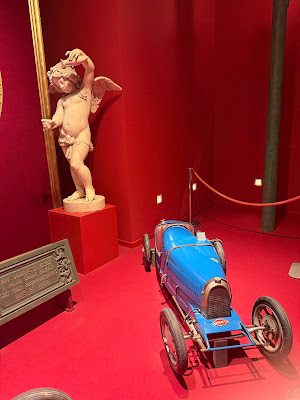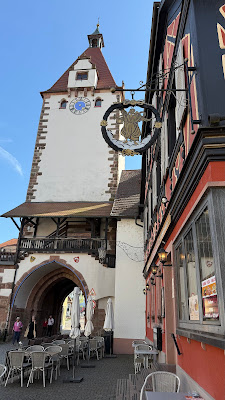Mulhouse
We continued to explore the area around Colmar. After Eguisheim, we drove to the city of Mulhouse, also in Alsace, to the National Automobile Museum that houses the Schlumpf Collection.
 |
| Kate and Mike Entering the Auto Museum |
This museum was fascinating and I highly recommend it. Even though cars are not necessarily my thing, we were enthralled with the range and variety of this automobile collection.
Hans and Fritz Schlumpf, or the Schlumpf brothers, were born in 1904 and 1906 in Italy to a father from Switzerland and a mother from Mulhouse, France. Their father was a textile industrialist and the brothers were Swiss citizens. They grew up in Mulhouse. They were initially wool brokers, made money speculating in various industries in the 1920s and amassed a large fortune. They bought up other textile mills and their company was the largest employer in the region until it went bankrupt in 1977. The automobile museum is in a former textile factory.
Fritz acquired his first Bugatti car at the age of 22 when he was a successful wool broker. There are 123 Bugattis in the collection.
 |
| 1927 Bugatti |
There were cars from so many manufacturers that no longer exist. Some of the earliest cars from the 1800s were in the collection. Their collecting accelerated after World War II.
 |
| 1890s Auto |
 |
| 1936 Alfa Romeo |
To fund their hobby the Schlumpf brothers encumbered their business to such an extent that by 1977 it became insolvent. Until this time the automobile collection was unknown to the public. However, their excesses were revealed in 1977 during a strike by the Schlumpf textile workers. In 1977, the French seized the Schlumpf Collection, which was then valued at 100 million French francs, and issued arrest warrants for the brothers. However, the brothers had already fled to Switzerland on their Swiss passports and Switzerland does not extradite its citizens. In 1983, both brothers were sentenced to prison terms of two to four years due to fraudulent bankruptcy and embezzlement, but they were safe in Switzerland. The Museum opened its doors in 1983.
 |
| 1927 Bugatti |
 |
| 1927 Child's Bugatti |
 |
1907 Nine-Passenger Hotel Bus
from the Vosges Mountains Region of France |
The Schlumpf brothers died in 1989 and 1992 in exile in Switzerland. Their legacy was their collection of about 450 cars that are now in the National Automobile Museum for us to enjoy.
Offenburg and Gengenbach
We decided to go over the border into Germany to visit a couple of old towns on the edge of the Black Forest. Offenburg is known as the Gateway to the Black Forest. We sampled yummy Black Forest Cake at the bakery in Offenburg.
 |
| Offenburg Bakery |
It did not take too long to see Offenburg and we were off to Gengenbach, a smaller little village nearby. The village was hopping on a late Saturday afternoon.
 |
| The Peppermill Restaurant |
 |
| Sande and Mike in Gengenbach |
 |
| Kate at the Village Gate |
In the early 20th century, the town became a center for the production of Black Forest cake.
 |
| Saturday Market |
 |
| Gengenbach |
We strolled through the Saturday artisan market and had gelato.
We enjoyed our little detour into Germany-and Mike was happy to drive on the Autobahn for a bit. It was so disorienting, though, to be in Germany after several months in France. I am so accustomed to being able to understand the French signs, menus, etc. after being in Paris for several months. It was rough to be in Germany and pretty much have no clue what things said. What an adventure!

















Seeing Gengenbach was a treat, literally as it had the best gelato I’ve ever tasted. I think my favorite experience there was the church. It was so unexpected inside. I also need to brush up on my German as I struggled with the signs and menus.
ReplyDeleteYes! Loved all this.
Delete